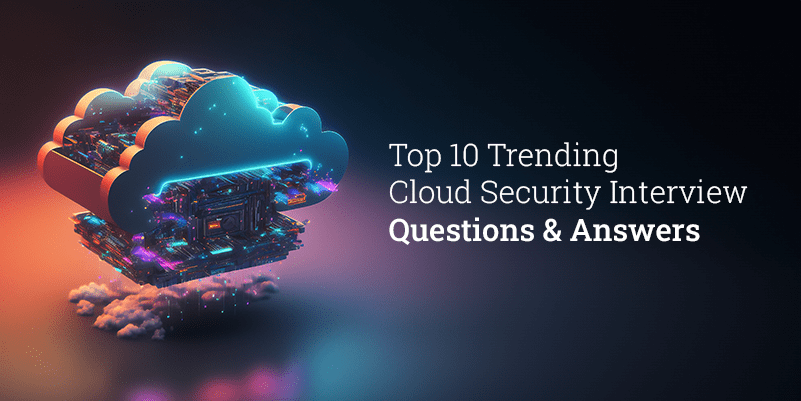Top 10 Trending Cloud Security Interview Questions & Answers

Top 10 Trending Cloud Security Interview Questions & Answers
In a rapidly evolving digital landscape, the cloud is not just the future; For now, it is a reality. According to a recent survey in the APAC region, 91.3% of organizations are actively using SaaS apps, representing an impressive 44% growth in the past year alone As this adoption is accelerating, the need for competent individuals to secure cloud environments is strong.
Companies are immediately looking for employees with theoretical skills and hands-on skills to strengthen their digital assets against cyber threats. This demand has led to a sharp rise in job openings, providing immediate opportunities for those ready to make an impact.
Our top 10 trending Cloud Security Interview Questions and Answers are designed to guide you through the intricacies of this dynamic field. These questions highlight the essential skills and competencies that employers look for in potential employees based on real-world situations.
1. What is cloud security, and why is it important?
Answer: Cloud security refers to practices, technologies, and policies designed to protect cloud-based assets, data, and infrastructure from various security threats and risks. It is crucial because as businesses increasingly adopt cloud services, the volume of sensitive data and critical applications stored in the cloud also grows. Proper cloud security ensures the confidentiality, integrity, and availability of these assets, safeguarding them from unauthorized access, data breaches, and other potential cyberattacks.
2. What are the common security risks associated with cloud computing?
Answer: Some common cloud security risks include:
Data breaches and unauthorized access.
- Insecure APIs (Application Programming Interfaces).
- DDoS (Distributed Denial of Service) attacks.
- Data loss and accidental deletion.
- Inadequate identity and access management.
- Misconfiguration of cloud resources.
- Inadequate encryption practices.
- Shared infrastructure vulnerabilities.
3. How do you ensure data privacy and compliance in the cloud?
Answer: To ensure data privacy and compliance in the cloud, one must follow these best practices:
- Implement strong encryption mechanisms for data at rest and in transit.
- Use access controls and multi-factor authentication to restrict unauthorized access.
- Regularly audit and monitor access logs to detect suspicious activities.
- Comply with relevant data protection regulations (e.g., GDPR, CCPA) based on the data’s jurisdiction.
- Conduct regular security assessments and risk assessments to identify vulnerabilities.
- Work with cloud service providers that offer compliance certifications.
4. What is the shared responsibility model in cloud security, and why is it important to understand?
Answer: The shared responsibility model is a crucial concept in cloud computing where the responsibility for security is divided between the cloud service provider and the cloud customer, basically making both parties understand their role in securing the cloud safe and secure. For example, the provider is responsible for securing the cloud infrastructure, while the customer is responsible for securing their applications, data, and access.
Understanding this model is essential because it clarifies which security aspects fall under the provider’s control and which the customer must manage. Failure to understand and implement the shared responsibility model can lead to security gaps and potential breaches.
5. How do you address the challenges of cloud security when migrating existing applications to the cloud?
Answer: When migrating existing applications to the cloud, it’s crucial to follow these security practices:
- Conduct a thorough security assessment of the application before migration.
- Ensure that the cloud provider meets necessary compliance standards.
- Implement proper access controls and authentication mechanisms.
- Encrypt sensitive data and transmit channels.
- Regularly monitor the application for any security vulnerabilities.
- Train the staff about the new security measures and best practices.
6. How do you respond to a security breach in the cloud?
Answer: In the event of a security breach in the cloud, the following steps should be taken:
- Immediately isolate and contain the affected systems to prevent further damage.
- Notify the relevant parties, including the cloud service provider and internal stakeholders.
- Preserve evidence for forensic analysis to understand the nature and scope of the breach.
- Remediate the vulnerability that led to the breach and deploy patches or updates.
- Conduct a post-incident analysis to identify the root cause and improve future security measures.
- Enhance security measures and reinforce security awareness and training within the
organization.
7. How can you ensure data security in the cloud?
Answer: To ensure data security in the cloud, several best practices can be employed:
- Encryption: Encrypt data both in transit and at rest to prevent unauthorized access.
- Access controls: Implement robust access controls to limit who can access specific data.
- Multi-factor authentication (MFA): Require multiple forms of authentication for user access.
- Regular backups: Create and store backups of critical data to prevent data loss.
- Data classification: Categorize data based on sensitivity to apply appropriate security measures.
- Security patches and updates: Keep software and applications up-to-date to address vulnerabilities.
- Data loss prevention (DLP): Implement DLP mechanisms to prevent the unauthorized transfer of sensitive information.
8. How do you handle security incidents in a cloud environment?
Answer: Handling security incidents in a cloud environment requires a well-defined incident response plan:
- Detection: Implement tools and monitoring to detect security incidents promptly.
- Containment: Isolate affected resources to prevent further damage.
- Investigation: Identify the root cause and extent of the incident.
- Mitigation: Take necessary actions to mitigate the impact and prevent recurrence.
- Communication: Notify relevant stakeholders, including customers and internal teams.
- Documentation: Thoroughly document the incident and response actions taken.
- Learning: Analyse the incident to learn from it and improve future security measures.
9. How can you assess the security of a cloud service provider before adopting their services?
Answer: When assessing a cloud service provider’s security, consider the following aspects:
- Security certifications: Check if the provider complies with industry standards like ISO 27001 or SOC 2.
- Data location and compliance: Ensure the provider adheres to relevant data protection laws and regulations.
- Security controls: Evaluate the security measures they have in place, such as encryption, access controls, and authentication mechanisms.
- Incident response capabilities: Understand their incident response plan and how they handle security breaches.
- Service-level agreements (SLAs): Review the SLAs regarding security guarantees and compensation for security-related issues.
- Customer reviews and references: Seek feedback from existing customers to gauge the provider’s track record.
- Vendor assessments: Conduct thorough vendor assessments, including security audits and risk assessments.
10. What is a “Zero Trust Architecture” model, and how does it relate to cloud security?
Answer: Zero Trust Architecture is a cybersecurity model based on the absence of implicit trust. The “Zero Trust” security model is based on the principle of “never trust, always verify.” This model is highly relevant to cloud security as it helps protect cloud resources by verifying the identity of users, devices, and applications attempting to access them, irrespective of their location. ZTA is a practice to defend against threats that exist both inside and outside of traditional network boundaries.
(Note: It is always advisable to give use cases to solidify the base of your knowledge and understanding of the concept.)
So here are some use cases of Zero Trust Architecture,
- Control over unauthorized access. (a situation called “shadow IT”)
- Multi-factor Authentication (MFA), can be based on hardware-based security tokens or soft tokens like OTP to double verify before giving access to the user to the data.
- Microsegmentation: Breaking up security perimeters into small zones to maintain separate access for separate parts of the network.
Understanding and implementing robust practices are the keys to mastering Cloud Security. To succeed in this ever-evolving field, stay up to date with industry trends, learn from real-life examples, and prepare for your next interview.
Best of luck on your Cloud Security journey!


